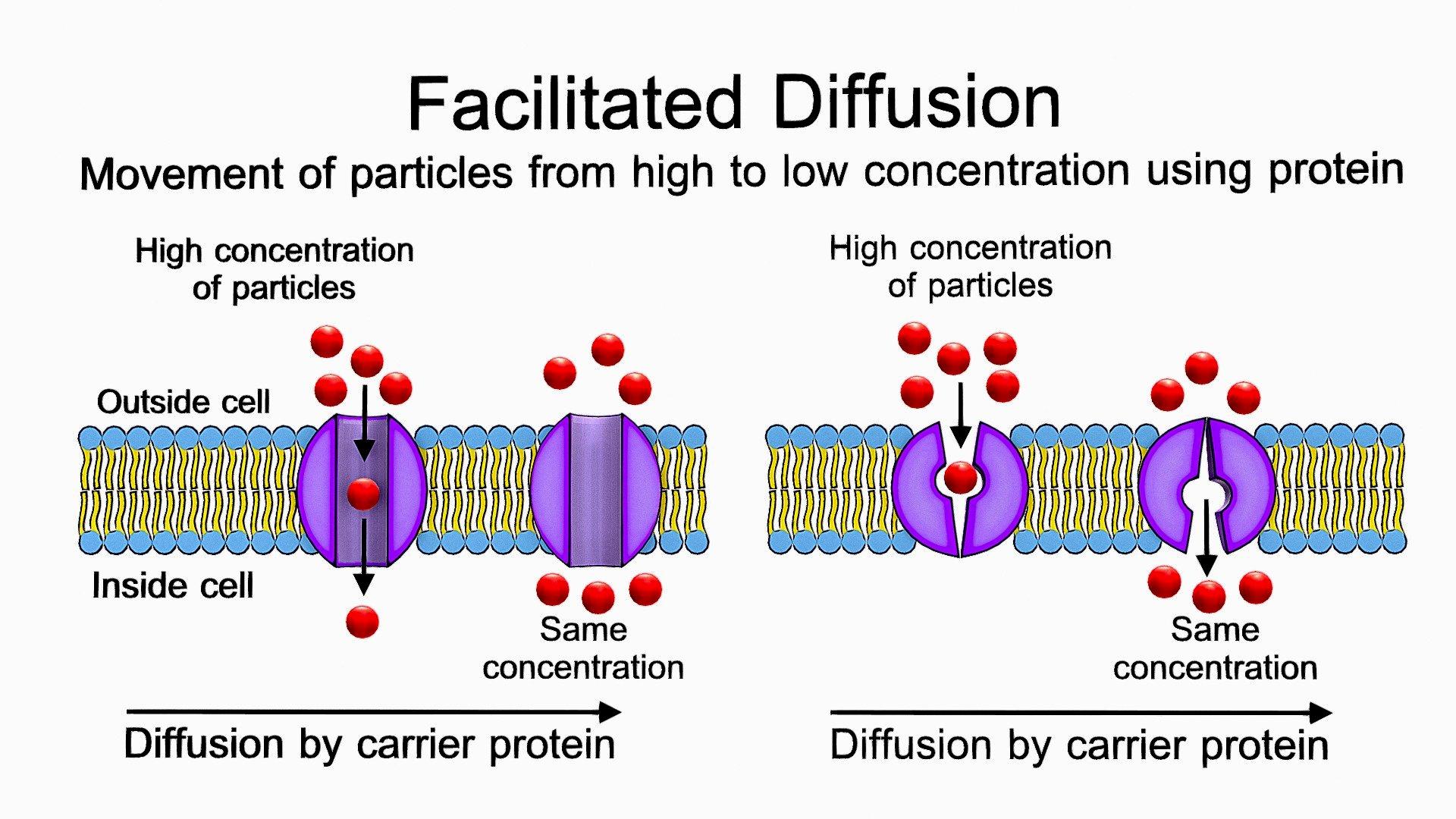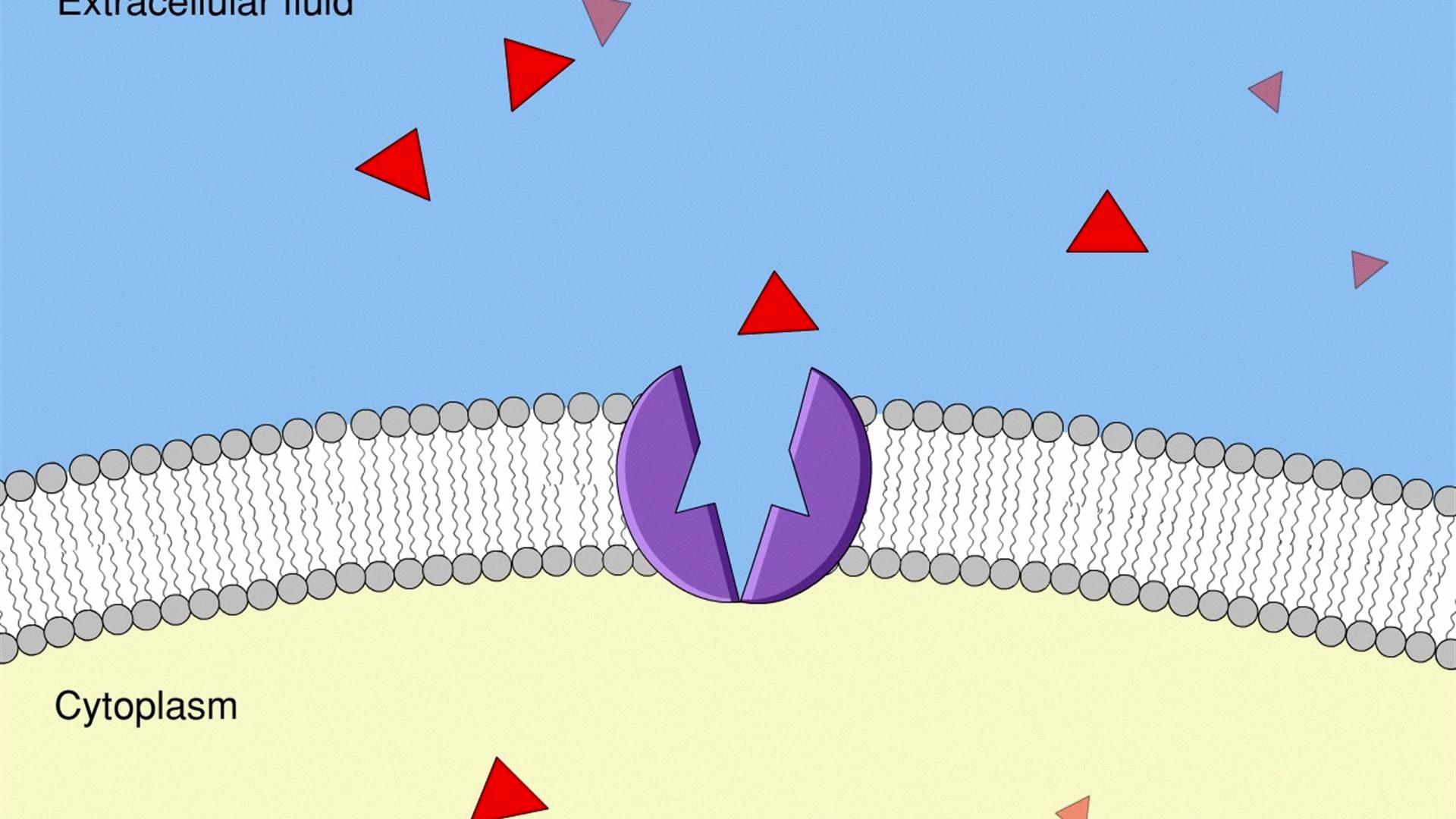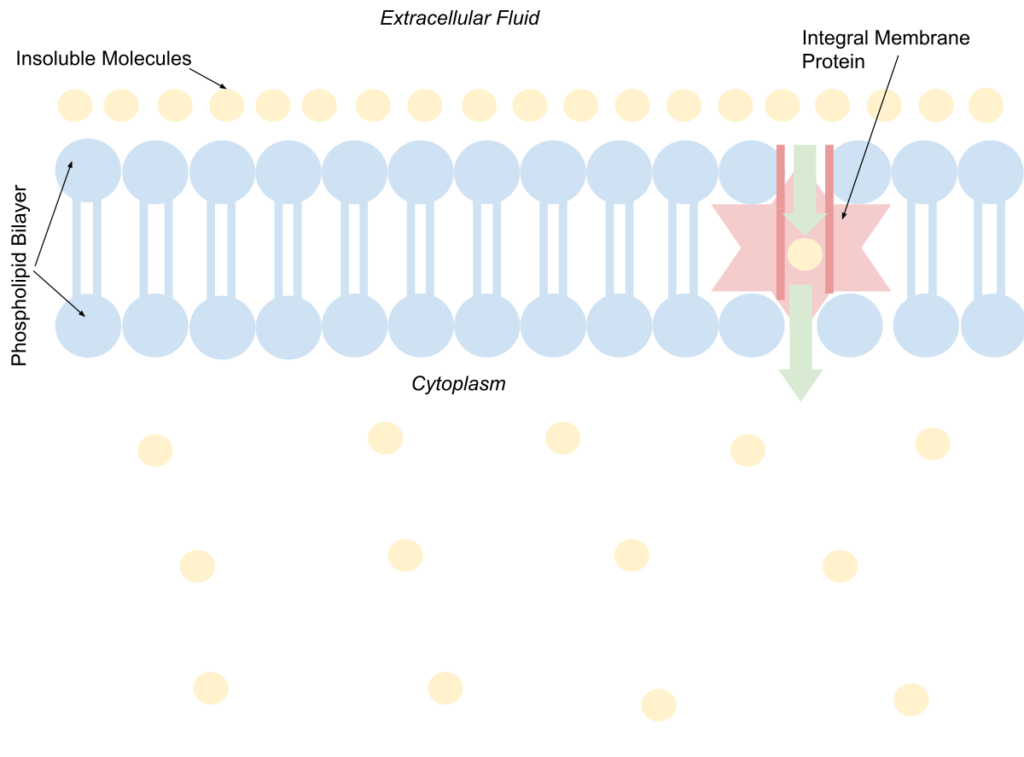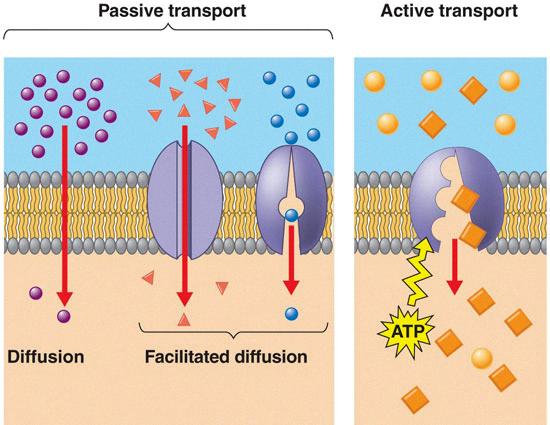Facilitated diffusion is a type of passive transport that allows molecules to move across cell membranes with the help of proteins. Unlike active transport, facilitated diffusion does not require energy from the cell. In this blog post, we will discuss the various factors that are required for the process of facilitated diffusion.
One of the primary factors that affect facilitated diffusion is temperature. As the temperature increases, the movement of the molecules also increases due to an increase in energy. This leads to an increase in the rate of facilitated diffusion. On the other hand, a decrease in temperature leads to a decrease in the rate of facilitated diffusion.
Another important factor that affects facilitated diffusion is the concentration gradient. Molecules move from areas of high concentration to areas of low concentration in facilitated diffusion. Therefore, the larger the concentration gradient, the faster the rate of facilitated diffusion. The concentration gradient is dependent on the number of molecules present in the area and their movement.
Facilitated diffusion also requires carrier proteins. These proteins act as channels for specific molecules, allowing them to move across the cell membrane. Carrier proteins undergo a conformational change that allows the molecule to be transported across the membrane. The specificity of the carrier protein determines which molecules can be transported.
Facilitated diffusion can occur in either direction depending on the concentration gradient of the molecule. If the concentration gradient is such that the molecule is more concentrated outside the cell, facilitated diffusion will move the molecule into the cell. Conversely, if the concentration gradient is such that the molecule is more concentrated inside the cell, facilitated diffusion will move the molecule out of the cell.
Facilitated diffusion is an important process that allows molecules to move across cell membranes withut requiring energy from the cell. Temperature, concentration gradient, and carrier proteins are the primary factors that affect facilitated diffusion. Understanding these factors is crucial in understanding the functioning of cells and their ability to transport molecules across their membranes.
Requirements for Facilitated Diffusion
Facilitated diffusion is a type of passive transport that involves the movement of large, polar or charged molecules across a cell membrane throgh specific protein channels. This process requires two things: specialized protein channels and a concentration gradient. The protein channels are embedded in the cell membrane and act as gatekeepers, allowing only specific molecules to pass through. The concentration gradient is the difference in concentration of a substance between two regions, and it provides the driving force for facilitated diffusion. In this process, molecules move from an area of high concentration to an area of low concentration, without requiring any energy input from the cell. Therefore, facilitated diffusion relies on both the presence of specialized protein channels and a concentration gradient to transport molecules across the cell membrane.

Source: sketchfab.com
Requirements for Facilitated Diffusion
Facilitated diffusion is a type of passive transport that allows the movement of molecules across a cell membrane. Unlike simple diffusion, facilitated diffusion requires the presence of specialized proteins called carrier proteins, which bind to specific molecules and help them to move across the membrane. These carrier proteins act as channels or gates that allow the molecules to pass through the membrane. Facilitated diffusion occurs in either direction depending on the concentration gradient of the molecule, meaning that it can move from an area of high concentration to an area of low concentration, or vice versa. This process is essential for the transport of large or polar molecules that would otherwise be unable to cross the membrane on their own.
Does Facilitated Diffusion Require ATP?
Facilitated diffusion is a process of passive transport in whch molecules move across the plasma membrane from an area of higher concentration to an area of lower concentration with the help of channel proteins or carrier proteins. Unlike active transport, facilitated diffusion does not require the input of high energy molecules such as ATP. Instead, the transport proteins involved in facilitated diffusion provide a pathway for the molecules to move across the membrane without expending energy. The transport proteins undergo conformational changes to facilitate the movement of the molecules, allowing them to pass through the membrane more easily. Therefore, facilitated diffusion is considered a passive process that does not require the use of ATP.
Facilitated Diffusion: What is Involved?
Facilitated diffusion is a passive process that involves the movement of molecules across the plasma membrane with the assistance of membrane proteins, such as channels and carriers. Unlike simple diffusion, facilitated diffusion requires the presence of specific membrane proteins that act as channels or carriers to facilitate the movement of molecules across the membrane. These proteins are typically selective and only allow certain types of molecules to pass through.
Facilitated diffusion occurs when there is a concentration gradient of molecules across the membrane, meaning that there is a higher concentration of molecules on one side of the membrane than the other. The molecules will naturally want to move down this concentration gradient, from an area of high concentration to an area of low concentration, but may be unable to do so without the assistance of membrane proteins.
Channels are proteins that form a pore through the membrane, allowing molecules to pass through. The selectivity of channels is determined by the size and shape of the pore, as well as the charge of the molecules. For example, ion channels allow only ions of a specific charge to pass through.
Carriers, on the other hand, undergo a conformational change when a specific molecule binds to them. This change alows the carrier to transport the molecule across the membrane. Carriers are often selective for specific molecules, such as glucose or amino acids.
Facilitated diffusion is an important process that allows cells to transport essential molecules, such as nutrients and ions, across the plasma membrane.
Requirements for Facilitated Transport
Facilitated transport requires the presence of specialized membrane proteins kown as transporters or carriers. These proteins are embedded in the cell membrane and work to assist the movement of specific molecules across the membrane. The transporters have a binding site that recognizes and selectively binds to the molecule being transported. Once the molecule is bound to the transporter protein, it undergoes a conformational change, allowing it to be transported across the membrane. The movement of the molecule is typically driven by a concentration gradient, meaning it will move from an area of high concentration to an area of low concentration. Facilitated transport is a passive process that does not require energy input from the cell.

Source: pearson.com
Factors of Diffusion
Diffusion is the process by wich particles move from an area of high concentration to an area of low concentration. There are two main factors that affect the rate of diffusion: concentration gradient and temperature. The concentration gradient refers to the difference in concentration between two areas. The greater the difference in concentration, the faster the rate of diffusion. This is because particles move from areas of high concentration to areas of low concentration in an attempt to reach equilibrium. Temperature is also a factor that affects the rate of diffusion. As the temperature increases, the particles gain more kinetic energy and move more quickly, which results in faster diffusion. the concentration gradient and temperature are the two main factors that affect the rate of diffusion.
Does Facilitated Diffusion Require ATP or Cellular Energy?
Facilitated diffusion is a type of passive transport that allows the movement of molecules across the cell membrane from an area of high concentration to an area of low concentration, with the help of specialized transport proteins. Unlike active transport, facilitated diffusion does not require the input of cellular energy in the form of ATP. However, it does require the presence of transport proteins, which are embedded in the cell membrane and act as channels or carriers to facilitate the movement of specific molecules. These transport proteins undergo a conformational change to alow the movement of the molecules across the membrane, but this process does not require energy from the cell. Therefore, facilitated diffusion is a type of passive transport that does not require ATP or cellular energy.
Factors Required for Facilitated Diffusion
Facilitated diffusion is a process that requires certain factors to occur. The fist factor is the presence of a concentration gradient. This means that there must be a difference in the concentration of molecules on either side of the membrane. The greater the difference in concentration, the faster the rate of facilitated diffusion.
The second factor that is required for facilitated diffusion to occur is the presence of specific transport proteins. These proteins are embedded in the membrane and act as channels or carriers for the molecules to pass through. The transport proteins are selective and only allow specific molecules to pass through.
The third factor is saturation. This means that the transport proteins have a limited capacity to transport molecules. Once all the transport proteins are occupied, the rate of facilitated diffusion will not increase, even if the concentration gradient is increased.
Temperature also affects the rate of facilitated diffusion. As the temperature increases, the rate of facilitated diffusion also increases. However, if the temperature becomes too high, the transport proteins may become denatured and lose their ability to transport molecules.
For facilitated diffusion to occur, there must be a concentration gradient, specific transport proteins, saturation, and an optimal temperature.
Does Facilitated Diffusion Require Energy?
Facilitated diffusion is a type of passive transport mechanism that allws small, polar molecules and ions to move across a cell membrane along their concentration gradient. Unlike active transport, facilitated diffusion does not require the expenditure of cellular energy (ATP) to move molecules or ions across the cell membrane. Instead, facilitated diffusion relies on the presence of specific membrane proteins called transporters or channels that facilitate the movement of molecules or ions across the membrane. These transporters or channels create a pathway for the molecules or ions to move across the membrane, allowing them to move from areas of high concentration to areas of low concentration. Thus, facilitated diffusion is an energy-efficient process that occurs spontaneously and does not require the input of external energy sources.

Does Facilitated Transport Require a Protein?
Facilitated transport requires the presence of specific membrane proteins to aid in the movement of molecules across the plasma membrane. These proteins are known as transporters or channels and act as selective gates, allowing only certain molecules to pass through. The transporters bind to the molecule beig transported and undergo a conformational change that moves the molecule across the membrane. The movement of molecules occurs along a concentration gradient and does not require any input of energy from the cell. Thus, facilitated transport is a type of passive transport that relies on the presence of membrane proteins for the movement of molecules across the plasma membrane.
Does Passive Diffusion Require ATP?
ATP (adenosine triphosphate) is not required for passive diffusion. Passive diffusion is a type of diffusion that occurs without the input of external energy, such as the hydrolysis of ATP. Instead, it relies on the random movement of molecules from an area of high concentration to an area of low concentration, following the concentration gradient. This process occurs until an equilibrium is reached, with equal concentrations of molecules on both sides of the membrane. Therefore, ATP is not involved in passive diffusion, but it is required for active transport processes that move molecules against ther concentration gradient, which require energy input.
The Role of ATP in Transportation
Active transport is the type of transport that requires ATP. During active transport, molecules or ions move against their concentration gradient, which means they move from an area of low concentration to an area of high concentration. This movement requires energy, which is provided by ATP (adenosine triphosphate) molecules in the cell. Active transport is important for a number of cellular processes, such as the absorption of nutrients by cells, the removal of waste products, and the maintenance of ion gradients across cell membranes. Without active transport, these processes wuld not be possible, and cells would not be able to function properly.
The Need for No Energy in Facilitated Diffusion
Facilitated diffusion is a type of passive transport that involves the movement of molecules from an area of higher concentration to an area of lower concentration, with the help of specialized protein channels or carriers. Unlike active transport, whih requires the input of energy in the form of ATP, facilitated diffusion does not require any energy input.
The reason for this is that the movement of molecules in facilitated diffusion is driven by the concentration gradient, which is the difference in concentration between the two areas. Molecules naturally tend to move from areas of higher concentration to areas of lower concentration until the concentration is equalized, a process known as diffusion. The protein channels or carriers in facilitated diffusion simply facilitate this movement by providing a specific pathway for the molecules to pass through the cell membrane, but they do not actively transport the molecules themselves.
Therefore, facilitated diffusion is a passive process that does not require any energy input from the cell or organism. It relies solely on the concentration gradient and the protein channels or carriers to facilitate the movement of molecules across the membrane.

Source: socratic.org
Facilitated Diffusion
Facilitated diffusion is a type of passive transport that involves the movement of substances across a cell membrane with the help of membrane-bound transport proteins. This process does not require energy from the cell and occurs down a concentration gradient, from an area of high concentration to an area of low concentration.
An example of facilitated diffusion is the movement of glucose across the cell membrane. Glucose molecules are too large and polar to pass through the lipid bilayer of the membrane, so they require the assistance of transport proteins called glucose transporters. These transporters bind to glucose molecules on one side of the membrane and undergo a conformational change to transport them across the membrane and release them on the other side. Another example of facilitated diffusion is the movement of ions, such as potassium or sodium, across the membrane through ion channels.
In contrast to facilitated diffusion, simple diffusion involves the movement of small, nonpolar molecules, such as oxygen or carbon dioxide, directly through the lipid bilayer of the membrane. Active transport, on the other hand, requires energy from the cell to move substances aganst their concentration gradient, from an area of low concentration to an area of high concentration.
Conclusion
Facilitated diffusion is a process that requires carrier proteins to transport molecules across the plasma membrane. This type of diffusion occurs in either direction depending on the concentration gradient of the molecule. Temperature and concentration are the main factors affecting the process of facilitated diffusion. Unlike active transport, facilitated diffusion does not require high energy molecules such as ATP. Instead, it uses channel proteins and carrier proteins to transport molecules across the membrane. Understanding the process of facilitated diffusion is crucial to understanding how cells maintain homeostasis and regulate the movement of molecules in and out of the cell.
